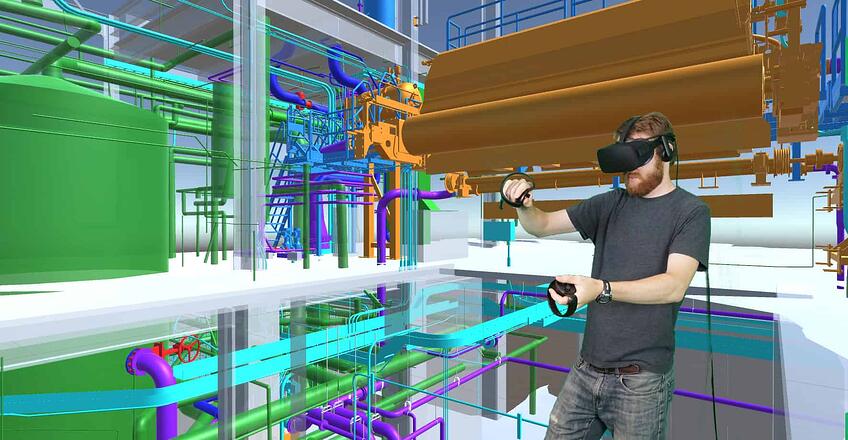Virtual reality technology can complement 3D modeling in civil engineering. It can offer better communication between the various stakeholders in training, education, and professional practice.
VR engineering education unlike traditional academic teaching methods, teaches through interactive three-dimensional geometric models. This could go a long way in creating more inspired active learners.
• According to Fortune Business Insights, the global virtual reality in the education market was USD 656.6 million in 2018. It is expected to reach USD 13,098.2 million by 2026, with a CAGR of 42.9% during the forecast period.
• According to TechJury’s VR statistics for 2021, the implementation and development of VR in engineering can reduce model design time by 10% and construction time by 7%.
Use Cases of Virtual reality in civil engineering education
The following are a few examples of some universities or tools that have experimented with civil engineering education using virtual reality technology.
1. Study at Technical University of Lisbon
A paper by A. Z. Sampaio, P.G. Henriques, O.P. Martins from the Department of Civil Engineering and Architecture, Technical University of Lisbon, talks about Virtual reality technology used in civil engineering education.
The authors say that the introduction of CAD and VR techniques in civil engineering education is very helpful. It benefits students in the educational process as well as in professional practice.
These applications allow the visual simulation of the physical progression of each type of work. It also assists in the study of the necessary equipment needed. In addition, it gives a detailed view of the equipment’s functioning.
2. Observations at Higher Technical Institute, Portugal
The Department of Civil Engineering and Architecture, Higher Technical Institute, Portugal, observed the following concepts from virtual reality applications in civil engineering.
• They presented the EON software (EON, 2011), a system of virtual reality technologies on developing the didactic models. It enabled the VR application use for many handlers.
• Via direct interaction with the models, it is possible to monitor the progress of the construction process. It analyzes the construction of the roof and bridges and access information relating to each component of the educational model.
• The roof VR model, an educational model, related to the graphic construction of a roof drawing, was created by Sampaio and Cruz in 2011.
• Bridge deck VR models are the bridge models. They allow the visual simulation of the construction of a bridge using two different construction methods: the cantilever process and the incremental launching method.
• In construction VR applications, construction progress monitoring has been recognized as one of the critical elements to the construction project’s success. Corrective measures and other appropriate actions can be taken promptly by monitoring construction progress. It enables the actual performance to be close to the desired outcome.
3. Didactic Models in Bridge Construction
Virtual reality-based applications heighten the experiences in civil engineering education. The applications such as didactic virtual models strive to support Civil Engineering education. It functions in the bridges and construction disciplines. It is useful both in classroom-based education and e-learning technology.
4.Innovation by IXR Labs in VR engineering Education
One more important educational tutorial in bridge construction is the depth video by IXR Labs. This video takes you on an industrial tour of the bridge construction site.
This step wise guide makes it easy to learn how to construct a terrestrial and an underwater bridge. Learners can engagingly experience each step from drilling to the placement of pillars and beams to enhance understanding and get familiar with the industry.
IXR Labs works in the higher education sector. It serves engineering education with its KLab-VR for engineering. It empowers learning with practical tools in a single virtual reality-based console. By covering 1000+ engineering concepts, and an in-depth assessment system, IXR Labs helps improve learning outcomes. It also offers VR based industrial tours and complex industrial setups.
Future of civil engineering with VR in engineering
Virtual reality in the civil engineering industry can ease the system and operations. Qualtrics performed an online survey in 2017-2018. The purpose of this survey was to look out for the opportunities for AR/VR technologies in AEC. Participants answered a few questions, and the following were the answers.
• AR/VR will drive a majority of the projects within the next 5 to 10 years. More than 70% of all respondents replied with “probably yes” or “definitely yes,” indicating the need for a significant rise in the adoption of AR/VR technologies.
• In addition, over the past year, the percentage of “definitely yes” and “probably yes” grew by 14%, showing a rapid and positive change in the industry trend.
Conclusion
There are many other possibilities of using VR engineering. The systems with these features make the learning process more robust, advanced, and self-evident. While designing an education system with virtual reality, one must consider the entire model’s pedagogical aspects and technical aspects.











